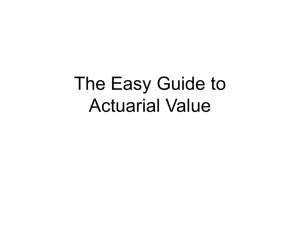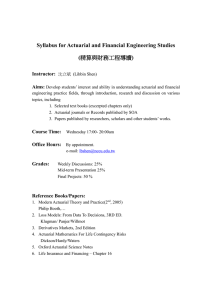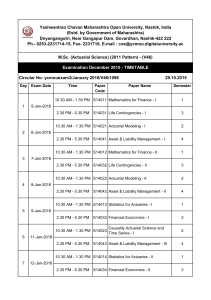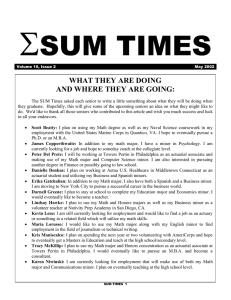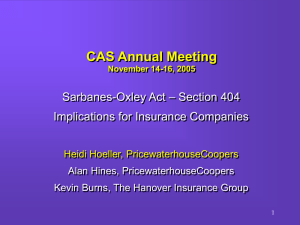Phase II Insurance Project Implementation Issues Scott Lewis
advertisement
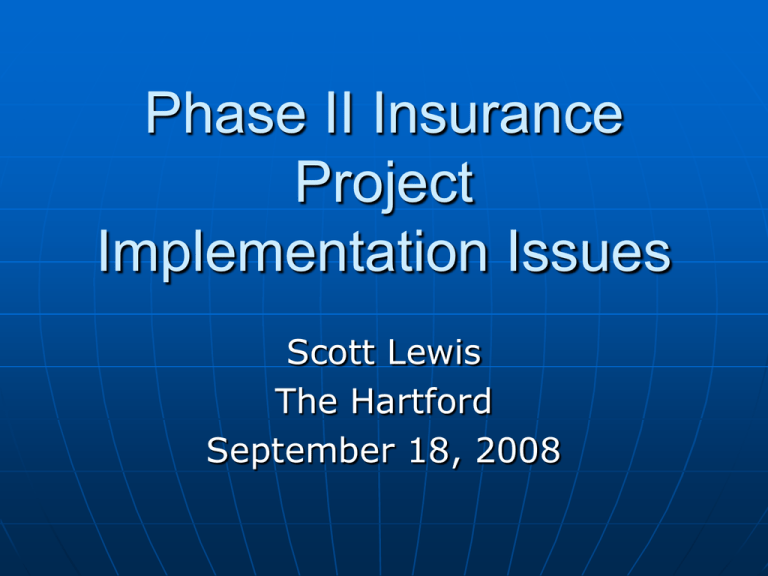
Phase II Insurance Project Implementation Issues Scott Lewis The Hartford September 18, 2008 The 3 building blocks 1. 2. 3. Determine the unbiased, marketconsistent, probability-weighted estimate of cash flows Discount the cash flows Determine the risk margin that market participants require for bearing risk Determining the unbiased estimate of cash flows What must a company do to prove that its estimate is “market consistent” and “probability weighted”? Does it differ from the “best estimate” we have today? What would happen if the new principle did not allow using deterministic methods to produce an estimate of cash flows? Can the estimate of undiscounted cash flows differ from the actuarial “mean”? Can there be a difference between the actuary’s point estimate and management’s estimate? Is there a “risk margin” already in the estimate of cash flows? Using conservative assumptions in actuarial methods Including an explicit “risk load” in cases of highly volatile lines Being conservative in selecting the actuarial indication among several methods Setting carried reserves above the mid-point of a statistical range Recording a reserve redundancy (the bestestimate carried reserves exceed the actuarial indication) “Market-consistent” Even if certain assumptions (like medical claim severity) could be isolated, there is not likely forward market data that could be used to calibrate those assumptions Can interest rate or inflation derivative market rates be used as assumptions in actuarial reserve estimates? Should these rates be “decoupled” from loss development factors or other assumptions used in today’s methodologies? IASB: Estimates of frequency and severity “should not contradict current market variables”. The burden is to demonstrate that assumptions are consistent with available external and internal data “Probability-weighted” Use stochastic modeling (like bootstrapping) to build a statistical distribution around a selected estimate of cash flows. This distribution of future paid losses would be used in the calculation of the risk margin. Stochastic modeling could be used to develop leverage ratios Discounting Market rate versus risk free rate If risk-free, determine what yield curve you will use as a proxy LIBOR-derived rates may be a viable option (e.g. swap rates) Select the expected payment pattern Payment patterns More analysis is needed in estimating how volatile claim payment patterns can be. Most accounting systems today discount only tabular (indemnity W/C) case reserves. Systems must be modified to accommodate discounting all case reserves for all accident years Need to discount IBNR as well Companies should keep track of IBNR by accident year Cost of capital method Risk margin is based on the difference between the assumed cost of capital and the risk free rate multiplied by the required capital Implementation issues-• How to calculate total required capital • How to attribute that capital to reserving lines within reporting segments • What is the appropriate cost of capital Required capital Could use stochastic modeling of loss & LAE distributions to determine the amount of capital that must be held to meet defined solvency requirements. Defining solvency requirements— ultimately, the solvency level depends on management’s risk tolerance (e.g 99.95% confidence level) But we really don’t know much about 1-in2000 year events What should be the cost of capital? 3rd party required return may be different if they are buying contracts in runoff versus an ongoing business Consider the following possibilities for Florida homeowners: • 15% target ROE embedded in the Company’s rate filing • 5% ROE embedded in the rates approved by the Florida Department of Insurance • 10% return a hypothetical 3rd party would require to be compensated for the risk of assuming contracts in runoff What the risk margin must consider Compensation for capital needed to support-• Variability due to process risk • Variability due to parameter risk • Variability due to model risk • The risk that the actual average payment date could be different from our selected average payment date • The risk that the actual interest rates could be different than our assumed rates Pre-claim liability: arguments against using UEPR as a proxy for fair value Unearned premium does not take into consideration what happens if there is a significant change in cash flow estimates such as due to: • The effect of a change in the current accident year reserve call • A significant event such as a hurricane that is about to make landfall right before quarter end The fair value of the pre-claim liability could change due to a change in interest rates (e.g. if six months after policy issuance, interest rates go down, the premium we collected is presumably less than the amount of premium that would be charged now and we would have a loss) Other considerations Reinsurance—estimate range of uncollectibility due to defaults and disputes Diversification of non-hedgeable risks Review every reserving line every quarter? Project management • • • • Get a project manager Identify actuarial system requirements Run general ledger in parallel Get pro forma statements prepared early on so you can manage investor expectations F/S and Disclosures If MD&A is presented using “old GAAP”, may need to maintain 2 sets of books May need to provide cumulative paid loss and reported loss triangles for gross and ceded business, not just for net Will likely need to disclose the effect that emerged loss trends could have or have had on the nominal best estimate and risk margin of the post-claim liability. Also disclose effect on the pre-claim liability

